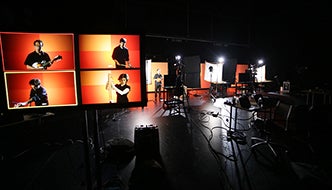
Through the Jaffe Student Production Competition, Ph.D. arts candidate Ryan Ross Smith worked at EMPAC this summer to create Opera3, a re-imagined version of the traditional opera, informed by the non-linear narrative logic of the Internet age.
Standing in the middle of the Studio 1 black box at the Curtis R. Priem Experimental Media and Performing Arts Center (EMPAC), Ute Besenecker says, “There’s no better space to do this work.” In four corners of the room, the Ph.D. architecture candidate and her small undergraduate research team have constructed isolated light environments consisting of curved screens, heavy black curtains, and a rig of different overhead lights. “Most studies happen in labs and light boxes,” she says of the way architectural lighting research is normally conducted, “so you can’t actually stand inside the environment.” Yet, with Studio 1 at her disposal, “it’s actually possible to do an architectural-scale study.”
Besenecker’s study is called “Beyond Appearances: Investigating Preference and Neural Correlates for Colored Light of Similar Chromaticity” and was conducted this summer at EMPAC with full funding and technical support courtesy of the Jaffe Student Production Competition, a first-of-its-kind opportunity extended to all Rensselaer students to support research contributing to their field of study. Following an open application process that began in fall 2014, two projects were selected from a range of proposals, drawn from every school on campus. The other winning project was “A Generative Opera for Reconfigurable Realtime Performance and Assemblage” from Ph.D. arts candidate Ryan Ross Smith.
Besenecker similarly sees the work she was able to complete in her time at EMPAC as the beginning of something much larger. Her work in theatrical and architectural lighting is predicated on the assumption that LED light will soon eclipse the use of incandescent bulbs. There are many ways to mix light in order to create particular hues. What Besenecker’s “exploratory” research aimed to establish was whether or not test subjects could detect the difference between light environments that were mixed from different sources. In order to do this, she conducted two cycles of tests with 15 subjects, exposing them to different renderings of the same shade of cyan and amber. Asked to describe the differences, this group yielded primarily qualitative results.
In a second cycle, Besenecker equipped the subjects with equipment to measure brain activity and heart rate, hoping to determine optimal mixes of these colors that wouldn’t have adverse affects on attention, irritability, etc. These LED mixing techniques are very new, so the data this study produces will help architects and theatrical designers better utilize these emerging tools.
The Jaffe Student Production Competition was initiated to extend to the student body the same resources and support afforded to the many international artists and researchers who work at EMPAC throughout the year.
While using EMPAC’s unique configuration of resources and support, Smith worked on his piece, Opera3, with the hope of making it presentable in other environments. Opera3 is a reimagined version of the traditional opera, informed by the non-linear narrative logic of the Internet age.
In the first phase of its production, Smith invited a number of musicians to perform parts of a libretto penned by collaborator Kelly Michael Fox, while standing in front of a screen featuring various projections. The second phase of the production residency involved extensive editing of this footage, ultimately chopping the material into short clips that could later be arranged in a multichannel display. The final phase of the project will consist of reconstituting all of this material through original software, which will randomize the selection of clips and play them through many monitors in an immersive gallery environment.
The source material that Smith gave his performers was drawn from Internet search terms that randomly selected content from a single day’s news cycle. In this way, a new constellation of meaning will be created for every audience member when they enter the gallery and navigate the opera.
“It’s old-fashioned to say to your audience, ‘this is the story I have to deliver,’” says Smith of the idea behind the piece. “Every human is going to see these relationships in a unique way. The beauty is letting it be in the eye of the beholder.”


